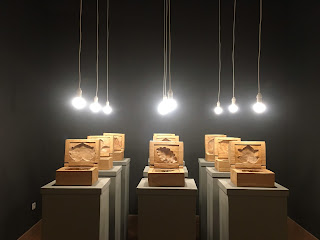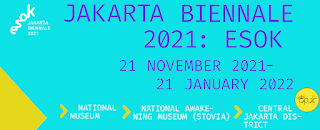Ulos, Hangoluan, & Tondi
A Life Journey Through the Threads
The role of
textile in Batak society from the private collection of Mrs. Luhut Pandjaitan
What are you
thinking about when someone asked you about Ulos? Yes, generally of us will
directly relating this traditional textile with Batak society. ‘Ulos, Hangoluan
& Tondi’ is the Batak traditional textile exhibition, where Ulos textile
will be always exist in every stage of life of Batak society. Hangoluan and
Tondi itself means life and soul, related to this exhibition that Ulos
traditional textile can’t be separated from life and soul of Batak society.
This
exhibition held for 14 days September 20th to October 7th,
2018 at Textile Museum in Jakarta. Sunday, September 30th, 2018
around 3.30 PM I arrived for the first at Textile Museum. This exhibition
displayed around 50 collections with each collection is not less than 50 years.
Ulos has a symbolic function that always be present in every aspect of Batak
society, starts from the birth phase, dynamic life, marriage, until the death.
“Stage of
Life” is the theme chosen by Del Foundation – an NPO that focuses on education,
heritage, and social causes – in creating an exhibition that aims to raise both
public awareness and interest in traditional Batak Ulos and the effort to
revitalize and preserve it. Titled ‘Ulos, Hangoluan, & Tondi’, the
exhibition is specifically made to target the younger generation, where old
textiles are framed in a conceptual and somewhat abstract fashion. This is done
to encourage understanding that our heritage has a place in the modern world.
This exhibition was really highlight that the importance of Ulos starting from
the very beginning of life, its dynamics, marriage, death, and even the
afterlife.
“I AM HAPPY
WITH WHAT I HAVE ALREADY ACHIEVED. NOW, IT’S ABOUT HOW MY LIFE CAN HELP OTHERS
ACHIEVE” -DEL FOUNDATION-
First time I
came in the building that exhibition held, the visitor will be welcomed with
“Introduction” room with the several white fabrics hanging around supported
with dim light yellowish then I was talking to myself this event will be great
to explore. Then continue to “Birth” room, the purple Ulos displayed in the
center of room that dominated with red light. Continued to “Life” room – a
representation of the flow and dynamics in one’s life. There are many
decorations included plants and photos of Ulos in Batak society in this room.
“Marriage” – in
Batak society, marriage is a celebration of life. There is one video projection
which is the only one in this exhibition that was playing the marriage ritual
tradition that held in Batak society. Then there are two white chairs as
installation of marriage aisle. The next stage is “Death” is not a time to
mourn, but a time to honor a fulfilled life. The light domination of this room
is grey tend to dark atmosphere, then precisely beside there are many yellow
light bulbs in the dark room. The last room was “Paradise” – At the end of
life, we found life once again. The previous room’s atmosphere is totally
different with this room, it was more likely the darkest side to the brightest
side because from the very limitation of light to full of light room. There is
one spot where the floor covered by glass that inside there are many light bulbs
then above it there was an installation looked-like a tree with the branches
and the leaves replaced by visitor’s small notes.
“Introduction Room”
“Birth Phase Room”
“Dynamic of Life Room”
“Batak’s Women with Ulos Textile”
“Elder Woman Wearing Beautiful Ulos Textile”
“Decoration in -Life- Room”
“Death Room”
“Death Room – Full of Light Bulbs”
“Paradise Room”
“Ulos, Hangoluan, & Tondi - Exhibition
Catalogue”
My score of
‘Ulos, Hangoluan, & Tondi’ exhibition is 8.7, this exhibition has a very
wonderful collections with several unique points such as, first there was an
interactive games with visitor named as “Find the Boraspati!” where the visitor
should find how many hidden “boraspati” inside the exhibition. Boraspati itself
means cicak or lizard in Batak language. Boraspati holds an important meaning to
the Batak people, it is central to their philosophy where adaptability and
strong survival instincts are admired. Unfortunately, after held a tiny survey
with my several Batak friends, only one out four friends slightly knew about
“boraspati”. Three of them even never heard “boraspati” itself. I wish there
will be more exhibition like this to increase the public awareness especially
the younger generation that at least should aware and more appreciating their
own amazing culture and heritage.
Second, on the
looked-like tree installation inside the “Paradise” room the exhibition visitor
can be participated to write down on the paper that already prepared about “What
are you grateful for today?”. I participated too, but for what I wrote become a
secret. 😉 Third, there was a big backdrop near to the
exit door with titled “Who Am I” that is consist with the Batak clan names such
as that I found my friend surname “Simangunsong”. For Batak people, surname is
a very important things, surname is an identity and pride. And the last, in my
opinion the application of collections and decorations of the main and sub
themes of the exhibition applied really great and the plot was really clear
then made the visitor drowned into another dimension of life.
This
exhibition sponsored by Yayasan Del, Tobatenun, Toba Sejahtera, Wonderful
Indonesia, Bank Mandiri, and Telkomsel then supported by ZigZag and The
Leonardi, Artotel as hotel partner, and Casa Indonesia as media partner.
Moreover, Textile Museum is above
of my expectation too. Beside of exhibition building, there are Batik gallery,
wastra introduction room, nature staining park, library, and Batik workshop.
FYI, wastra is absorption word of Sanskrit language it has meaning as a piece
of textile. In the other word, wastra is not an ordinary textile but Indonesian
traditional textile which has own meaning and symbol.
After around 30 minutes explored this exhibition, my basic
knowledge of textile as general and Ulos as special had increased. The
exhibition theme’s plot, all collections and decorations, installations, and
atmosphere of the exhibition and museum environment are really beautiful and
amazing artworks. Thank you very much for the hard work and dedication for all
the organization, community, sponsor, supporter, and partner until this amazing
exhibition can be held in Textile Museum.
Thank you for the reader of my blog and please waiting for
the next post. 😊
For further information :
Toba Tenun
Instagram : @tobatenun
Phone : +6221-7391-0435
Textile Museum
Instagram : @tobatenun
Phone : +6221-7391-0435
Textile Museum
Jl. KS Tubun No. 2-4 RT.004/002
Palmerah, West Jakarta
021-560-6613
Museum opens Tuesday – Sunday 9 AM – 4 PM
021-560-6613
Museum opens Tuesday – Sunday 9 AM – 4 PM
Generally, museum in Jakarta closed on Monday
Bibliography :
·
‘Ulos, Hangoluan, & Tondi’ exhibition
catalogue
·
Personal photos and documentation
· Personal impression and experience
·
Pesona, Redaksi. “Mengenal Ragam Jenis Ulos di
Museum Tekstil”. October, 16 2018. https://pesona.travel/inspirasi/446/mengenal-ragam-jenis-ulos-di-museum-tekstil
·
Maulidi, Achmad. “Arti Kata Wastra”. October, 16 2018. https://www.kanalinfo.web.id/2017/09/arti-kata-wastra.html?m=1





















This article has provide me a lot of information regarding Ulos. Thank you for sharing your experience!
ReplyDeleteThank you for your comment and time for reading this blog. Looking forward for your further support to the upcoming post.
Delete